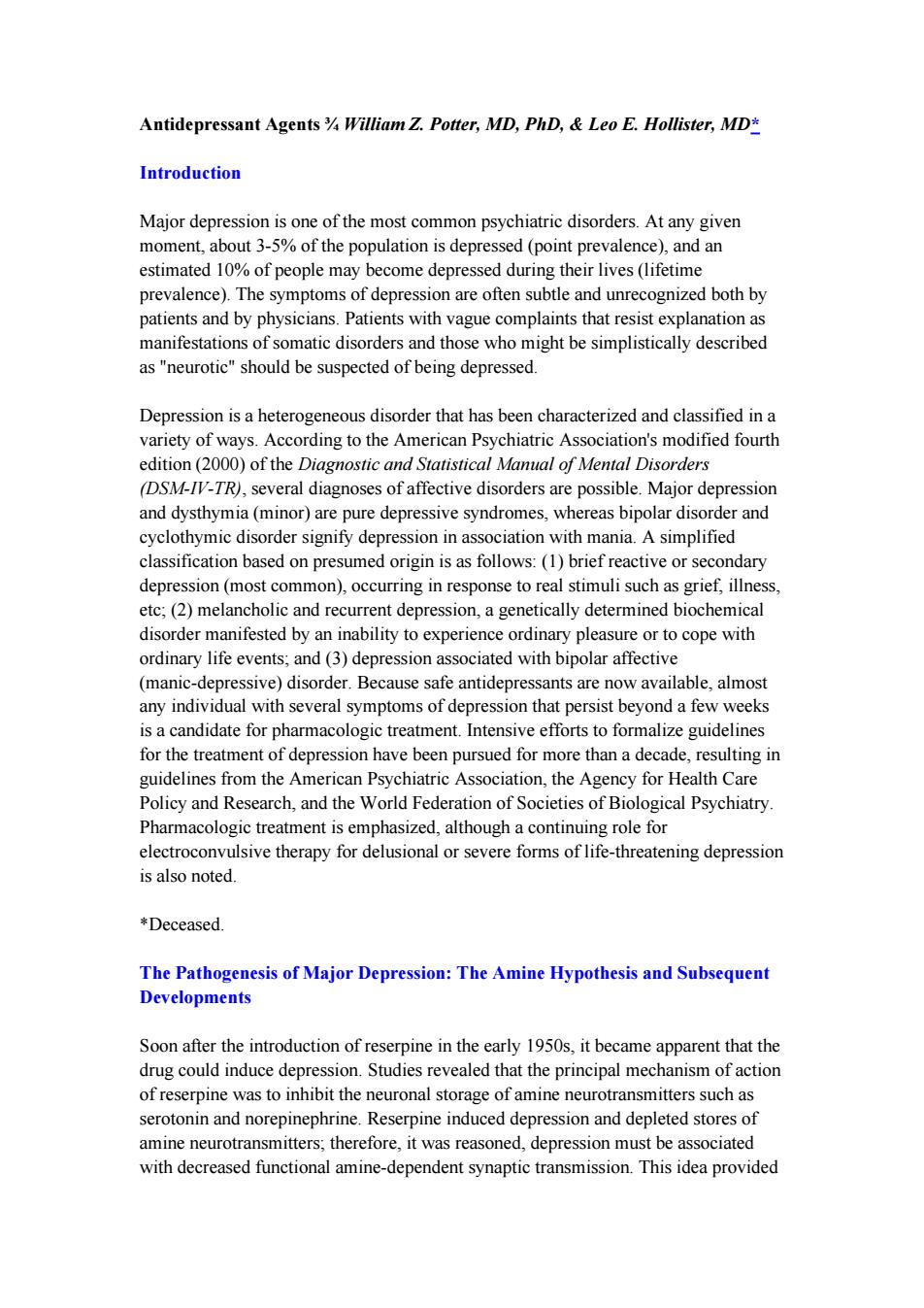正在加载图片...

Antidepressant Agents William Z.Potter,MD,PhD,Leo E.Hollister,MD* Introduction Major depression is one of the most common psychiatric disorders.At any given moment,about 3-5%of the population is depressed(point prevalence),and an estimated 10%of people may become depressed during their lives(lifetime prevalence).The symptoms of depression are often subtle and unrecognized both by patients and by physicians.Patients with vague complaints that resist explanation as manifestations of somatic disorders and those who might be simplistically described as "neurotic"should be suspected of being depressed. Depression is a heterogeneous disorder that has been characterized and classified in a variety of ways.According to the American Psychiatric Association's modified fourth edition (2000)of the Diagnostic and Statistical Manual of Mental Disorders (DSM-IV-TR),several diagnoses of affective disorders are possible.Major depression and dysthymia(minor)are pure depressive syndromes,whereas bipolar disorder and cyclothymic disorder signify depression in association with mania.A simplified classification based on presumed origin is as follows:(1)brief reactive or secondary depression(most common),occurring in response to real stimuli such as grief,illness, etc;(2)melancholic and recurrent depression,a genetically determined biochemical disorder manifested by an inability to experience ordinary pleasure or to cope with ordinary life events;and (3)depression associated with bipolar affective (manic-depressive)disorder.Because safe antidepressants are now available,almost any individual with several symptoms of depression that persist beyond a few weeks is a candidate for pharmacologic treatment.Intensive efforts to formalize guidelines for the treatment of depression have been pursued for more than a decade,resulting in guidelines from the American Psychiatric Association,the Agency for Health Care Policy and Research,and the World Federation of Societies of Biological Psychiatry. Pharmacologic treatment is emphasized,although a continuing role for electroconvulsive therapy for delusional or severe forms of life-threatening depression is also noted. *Deceased. The Pathogenesis of Major Depression:The Amine Hypothesis and Subsequent Developments Soon after the introduction of reserpine in the early 1950s,it became apparent that the drug could induce depression.Studies revealed that the principal mechanism of action of reserpine was to inhibit the neuronal storage of amine neurotransmitters such as serotonin and norepinephrine.Reserpine induced depression and depleted stores of amine neurotransmitters;therefore,it was reasoned,depression must be associated with decreased functional amine-dependent synaptic transmission.This idea providedAntidepressant Agents ¾ William Z. Potter, MD, PhD, & Leo E. Hollister, MD* Introduction Major depression is one of the most common psychiatric disorders. At any given moment, about 3-5% of the population is depressed (point prevalence), and an estimated 10% of people may become depressed during their lives (lifetime prevalence). The symptoms of depression are often subtle and unrecognized both by patients and by physicians. Patients with vague complaints that resist explanation as manifestations of somatic disorders and those who might be simplistically described as "neurotic" should be suspected of being depressed. Depression is a heterogeneous disorder that has been characterized and classified in a variety of ways. According to the American Psychiatric Association's modified fourth edition (2000) of the Diagnostic and Statistical Manual of Mental Disorders (DSM-IV-TR), several diagnoses of affective disorders are possible. Major depression and dysthymia (minor) are pure depressive syndromes, whereas bipolar disorder and cyclothymic disorder signify depression in association with mania. A simplified classification based on presumed origin is as follows: (1) brief reactive or secondary depression (most common), occurring in response to real stimuli such as grief, illness, etc; (2) melancholic and recurrent depression, a genetically determined biochemical disorder manifested by an inability to experience ordinary pleasure or to cope with ordinary life events; and (3) depression associated with bipolar affective (manic-depressive) disorder. Because safe antidepressants are now available, almost any individual with several symptoms of depression that persist beyond a few weeks is a candidate for pharmacologic treatment. Intensive efforts to formalize guidelines for the treatment of depression have been pursued for more than a decade, resulting in guidelines from the American Psychiatric Association, the Agency for Health Care Policy and Research, and the World Federation of Societies of Biological Psychiatry. Pharmacologic treatment is emphasized, although a continuing role for electroconvulsive therapy for delusional or severe forms of life-threatening depression is also noted. *Deceased. The Pathogenesis of Major Depression: The Amine Hypothesis and Subsequent Developments Soon after the introduction of reserpine in the early 1950s, it became apparent that the drug could induce depression. Studies revealed that the principal mechanism of action of reserpine was to inhibit the neuronal storage of amine neurotransmitters such as serotonin and norepinephrine. Reserpine induced depression and depleted stores of amine neurotransmitters; therefore, it was reasoned, depression must be associated with decreased functional amine-dependent synaptic transmission. This idea provided